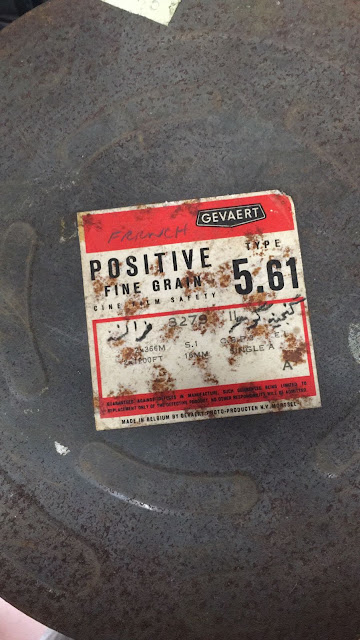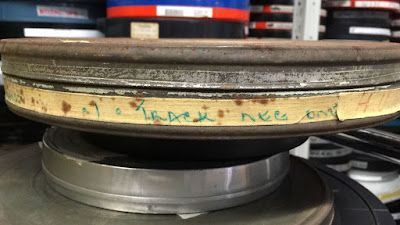Ebrahim Golestan's 1965 short documentary, Ganjineha-ye Gohar [in English: The Crown Jewels of Iran], will be screened at International Film Festival Rotterdam 2021. This will mark the world premiere of the restored version and a new beginning for a film very difficult or even impossible to screen in a cinema for almost 55 years. Like its title, The Crown Jewels of Iran is a true jewel of Iranian cinema, though so far a buried one.
Made for the Central Bank of Iran to celebrate the collection of precious jewels kept in the treasury, this film remains filmmaker Ebrahim Golestan's most visually dazzling work, embellished with terrific camera movements.
Some of the most iconic landscape photography in the history of Iranian cinema can be found within a minute after the opening credits, in which peasants of various ethnicities and tribes are quickly reviewed, all posed in a graceful manner, like kings without being kings. Like a work of musical composition, a simple act of ploughing is spread across shots of various size and angle, creating an intimate visual symphony. And then appears one of Golestan's allegorical match-cuts: a farmer seen on the horizon before a cut to a diamond on a dark background – the farmer is the jewel.
As in his previous "commissioned" films, Golestan manages to subvert the subject by a brave rejection, here, in the form of being openly critical of the Persian kings. The theme of the commentary is in clear contrast with what is shown: colourful images of jewels in rotation while Golestan's voice is heard, describing the decadence and treachery of past kings.
The Crown Jewels of Iran may well be one of the most beautiful colour documentaries ever made.
* * *
THE CROWN JEWELS OF IRAN (1965)
Writer, director, editor, producer: Ebrahim Golestan. Director of photography: Soleiman Minassian. Composer.: Hossein Dehlavi. Voice-over.: Ebrahim Golestan. Produced by Golestan Film Studio. (There is a French version of this film available too, albeit highly censored. More about that later.)
* * *
Chronology of the restoration:
1964-65: Produced and directed by Ebrahim Golestan, the film was made for the Central Bank of Iran at Golestan Film Studio. According to Golestan, various versions in English, French and Persian were produced.
1965: The completed film was screened for the Shah of Iran. According to Golestan, he praised the film. However, shortly after, the film fell victim to censorship and was never publicly shown.
June 2014: A video copy of the film, produced from a 35mm positive held at the University of Chicago, was screened after a talk about Iranian cinema at Edinburgh International Film Festival. It didn't look good. Golestan was present. I suggested doing something about this and he gave me his blessing.
 |
| What I first saw of this film on video looked like this |
June 2016: I put together a retrospective dedicated to Ebrahim Golestan at Il Cinema Ritrovato. The Crown Jewels of Iran was screened from a fairly fine, if reddish print, courtesy of the University of Chicago that holds a collection of Golestan's features and shorts. The film begged for restoration. Pauline Soh, from National Gallery Singapore, saw the film there, loved it and showed interest in co-funding a restoration. Cineteca di Bologna got an board, too. And then my search for tracking down the original elements of the film began.
 |
| "Jewels" in the can |
Early 2017: After some months of research I managed to find the original camera and original (Persian) sound negatives at Technicolor vaults in the UK. Robert Hoffman of Technicolor kindly helped us to release the material to Cineteca di Bologna.
I also discovered the French sound negative of the film at Golestan's house in England and sent it to Bologna where it was scanned.
 |
| Examining the elements at L'Immagine Ritrovata laboratory in Bologna |
October 2017: The preliminary restoration work was carried out at L'Immagina Ritrovta laboratory in Bologna, Italy. We discovered that where the duration of the film in different versions is exactly the same, the sound mix is different. This revealed the extent of the "censorship": In the French version, as well as the Persian mix of some prints, the soundtrack was mixed in a completely different way to divert the attention from criticism to praise, making a colourful propaganda out of a subversive masterpiece. In the "censored" mix, all the lines of voice-over talking about the treachery of Persian kings were eliminated.
The sound negative discovered at Technicolor was complete except one line where it says "And the Pahlavi Crown, like the full stop at the end of the tale."
 |
| The sound turned out to be the key issue in restoring the film |
Right after completing the main phase of restoration, we had a screening of the film at National Gallery Singapore. It was a way of presenting it to the co-sponsors of the project. I couldn't make it to Singapore but Mitra Farahani, the filmmaker who is making a documentary about Mr. Golestan, attended the screening and described the result as "astounding on big screen."
May 2018: Now it was Mr Golestan's and my turn to see the film on big screen. I hired Close-Up Cinema in East London and showed the result of our work to Mr. Golestan. He asked for certain changes in colour grading, especially in a landscape scene. I made a list of the small things that needed to be corrected and passed it on to Cineteca.
 |
| The line spoken on this shot couldn't be retrieved and had to be re-recorded. This frame is from the Chicago print which we used as reference. |
 |
| The restored shot with the added line. |
June 2018: At Golestan's place, I recorded the only line of narration which was censored and lost. (See above) The idea was to add that sound bite to the restored soundtrack. Golestan had originally recorded the voice-over in 1964-65 with his own voice. Naturally, his voice has changed a great deal since then but the sound engineer in Bologna did a fine job in digitally manipulating it to make sound as close to other parts of the narration as possible. However, I was consciously bringing a new dimension to the film by adding the voice in a manner which was clearly different from the rest of the film. It becomes a moment when it is both the film as it was and a documentation of its troubled past. We didn't hide it from the viewer.
 |
| The censored French sound |
Mid-2018: Worked with Golestan on improving the English subtitles (originally his translation, done in the 60s). He rejected most of the suggestions that Yusef Sayed and I made. In effect, it remains very close to the original subtitles but there are some subtle changes here and there. Goelstan's prose (which is closer to poetry) is hard to translate. With Yusef, we tried to make it sound more cinematic and we failed. The auteur's version prevails.
 |
| The Crown Jewels of Iran, restored |
After this, we got heavily involved in restoring other films by Ebrahim Golestan (including Brick and Mirror) and the completion of this project (including dealing with the censored line and updating the colour-grading) was sidelined until late 2020.
 |
| Then |
 |
| Now |
February 2021: In Bologna, under the supervision of Cecilia Cenciarelli (Cineteca) and Elena Tammaccaro's (the laboratory), the last touches were applied to restoration and restoration title cards were added.
 |
| Then |
 |
| Now |
June 2021: The world premiere of the new restoration at International Film Festival Rotterdam (June 2-6).
 |
| Now you'll be able to see it like this |


دست مریزادی نثار شما و همۀ آنها که قدر جواهرات گلستان را دانسته اید و در حفظ و احیای آن تلاش کرده اید.یک ماهی دیگر که حاصل ذوق و نبوغ گلستان و ثمرۀ کوششهایتان را بر پرده می بینید چشمان ما را هم از این دیار غریب به ضیافت آن گوهر کمیاب بخوانید.
ReplyDeleteامیدوارم روزی به شکل درست در ایران هم نمایش داده شود
DeleteThanks, Ehsan. For me, this is Golestan's greatest film, worthy of Resnais and even better thah "Brick and Mirror".
ReplyDeleteIndeed, Jonathan! I hope you could see it on big screen soon.
Delete